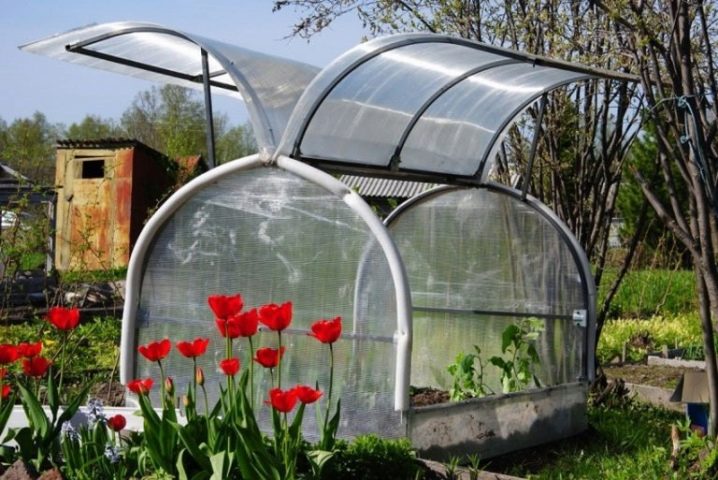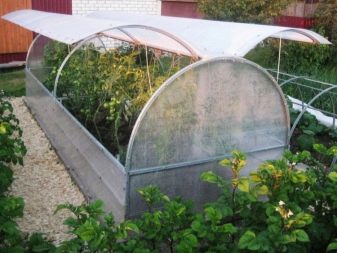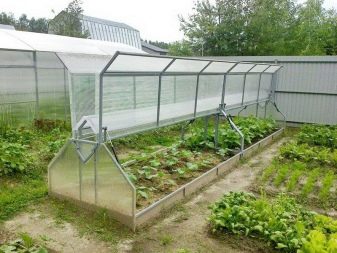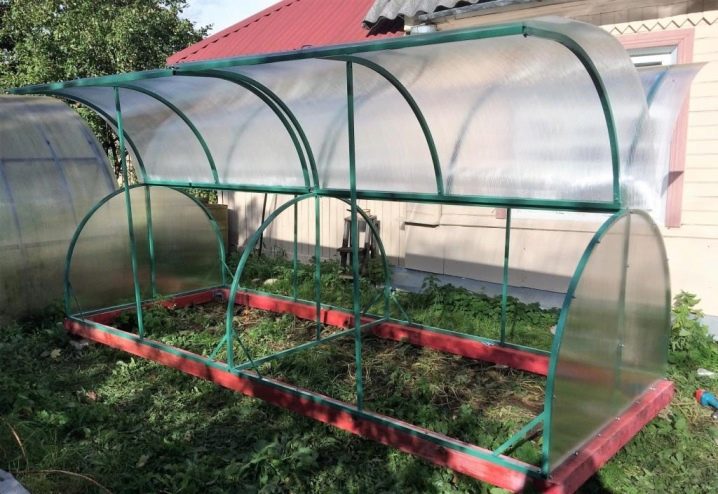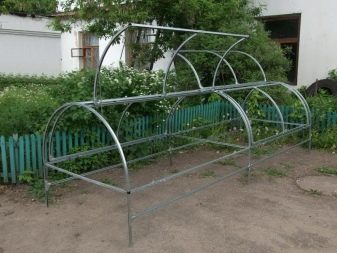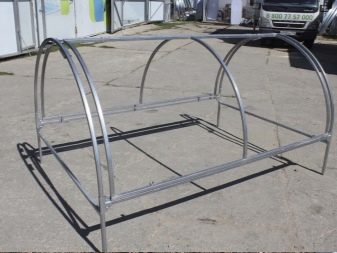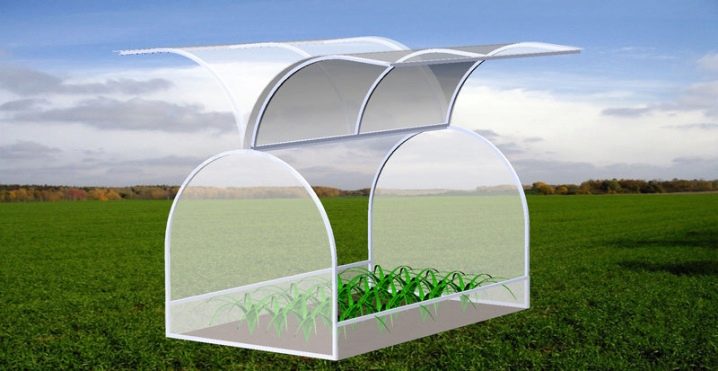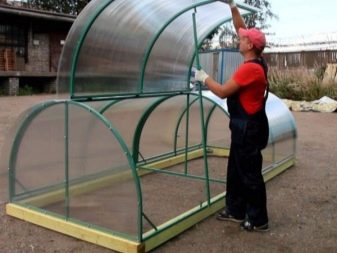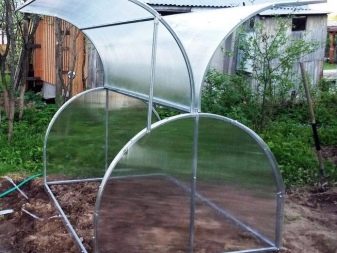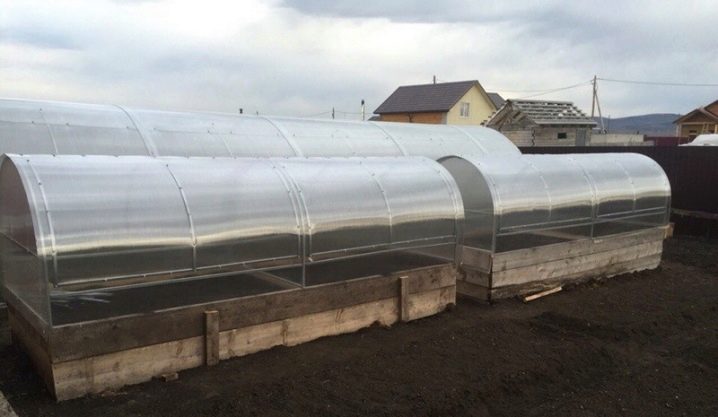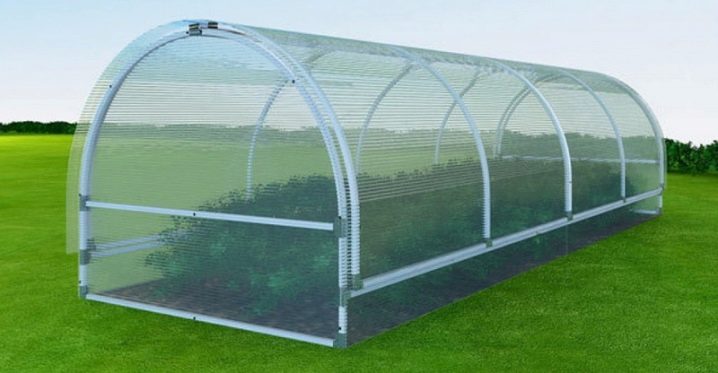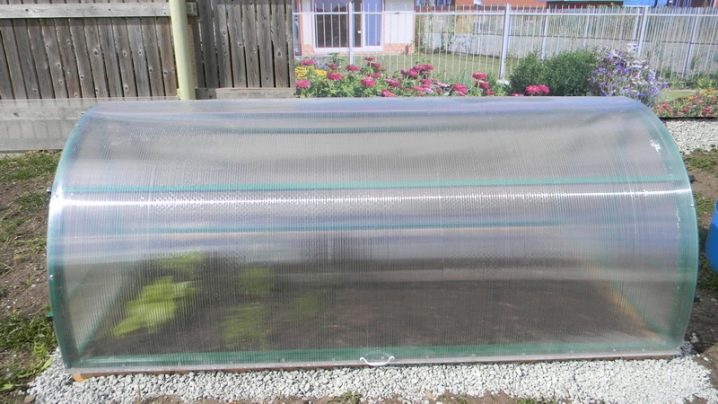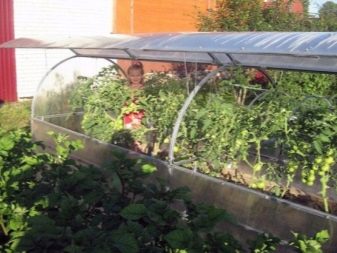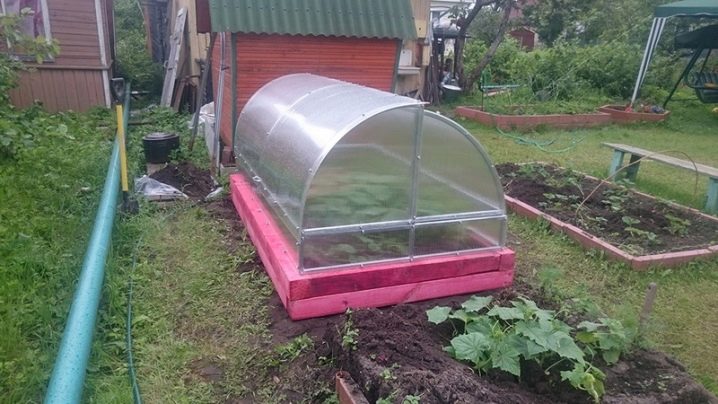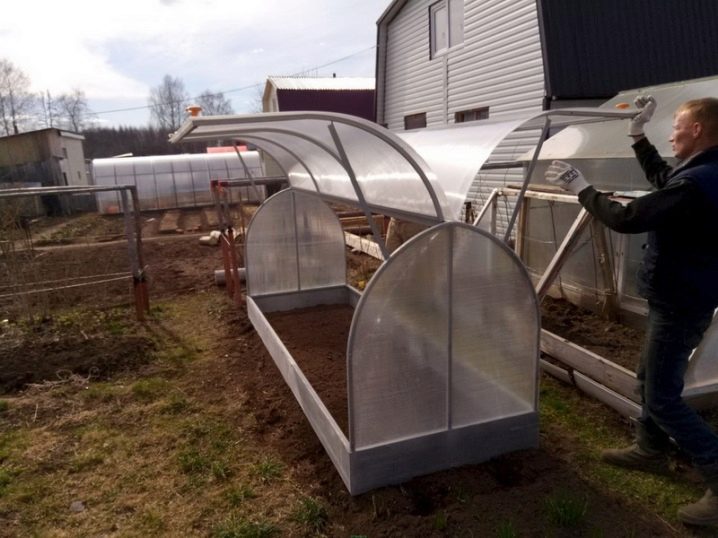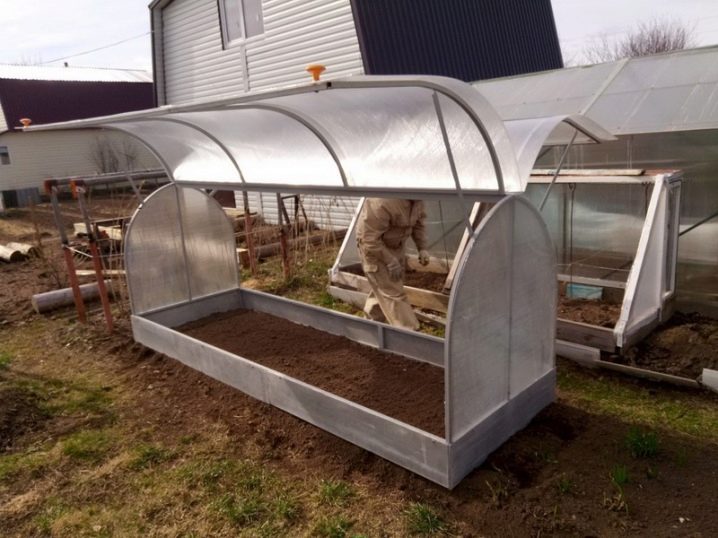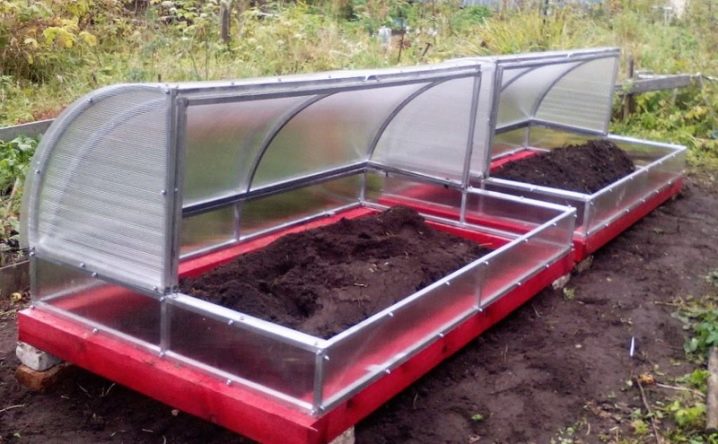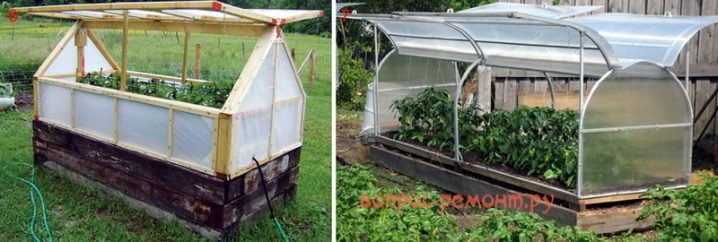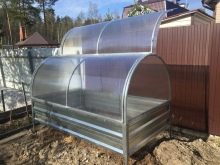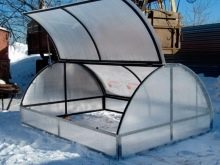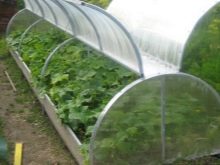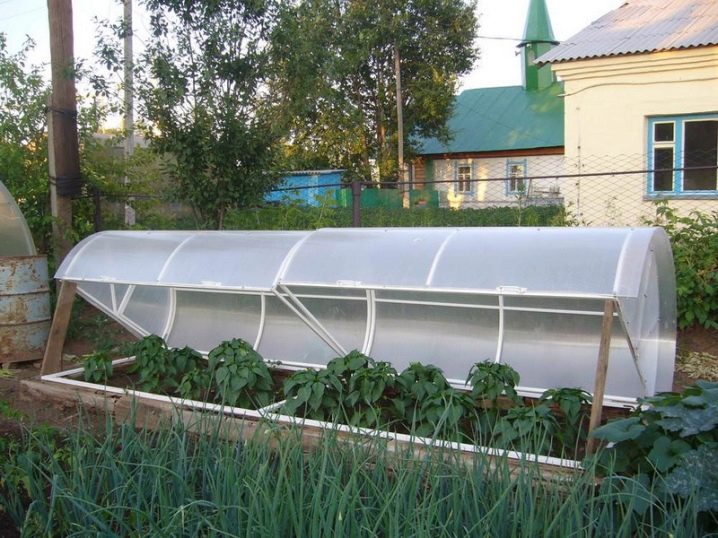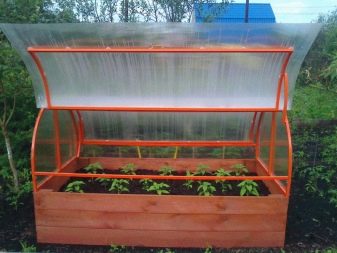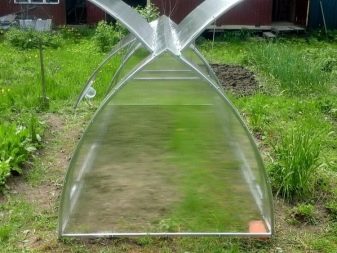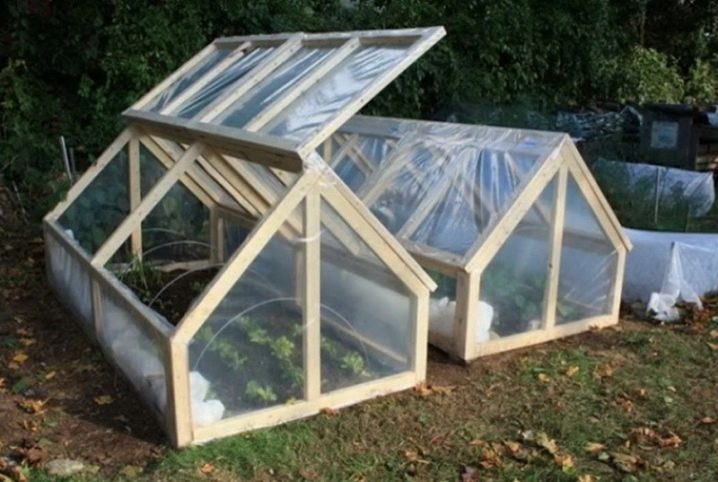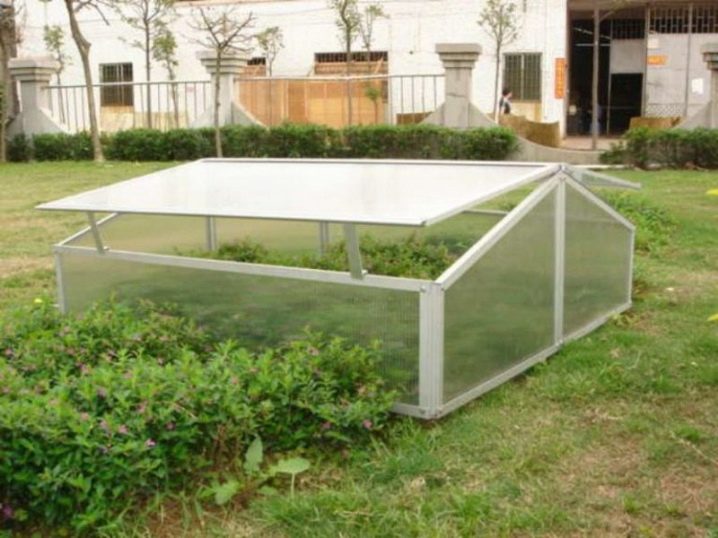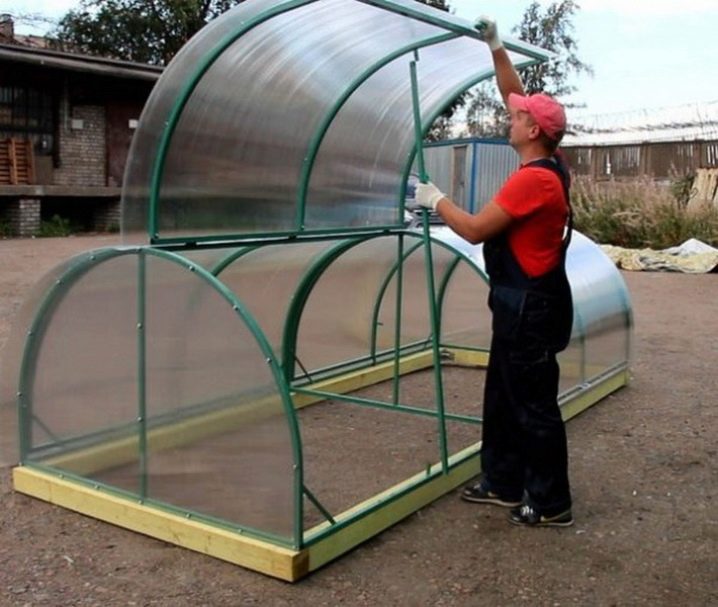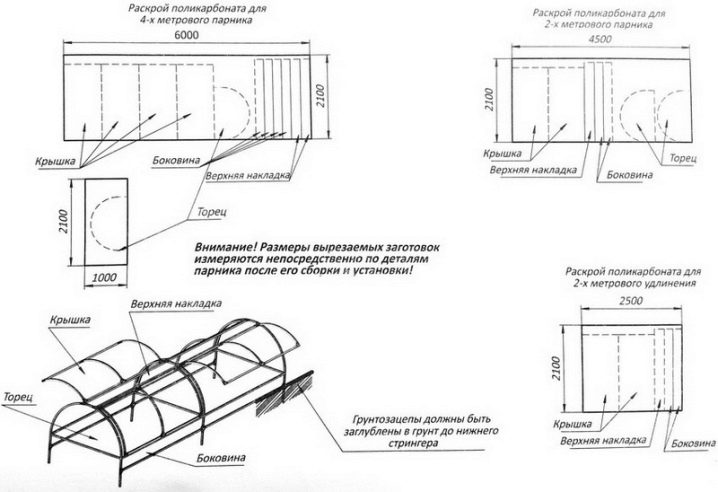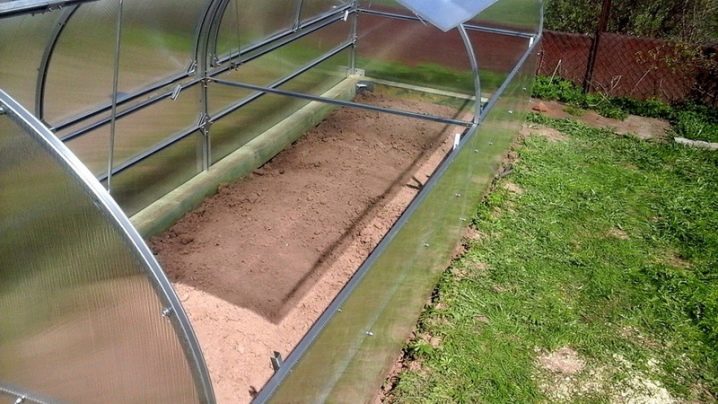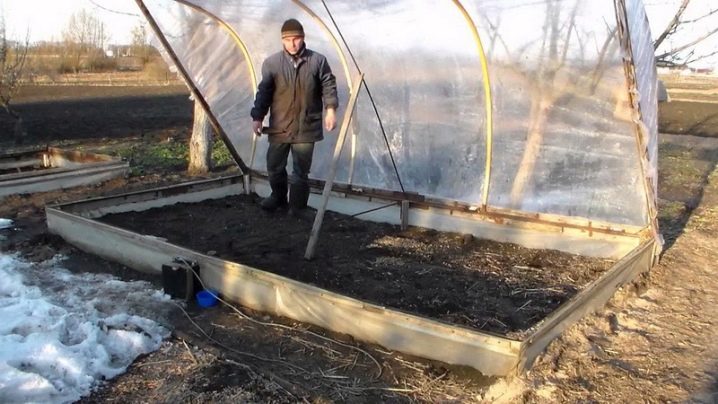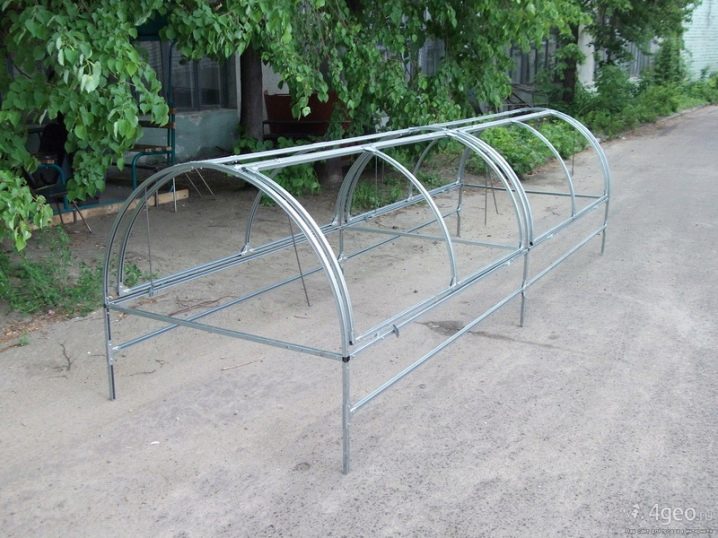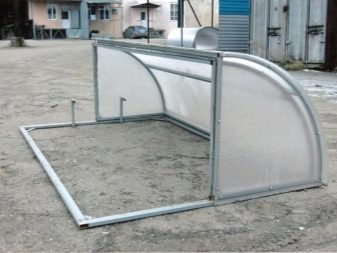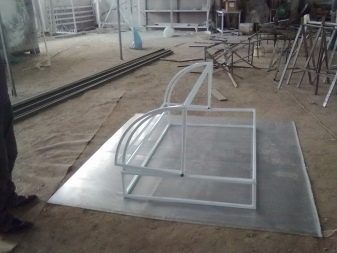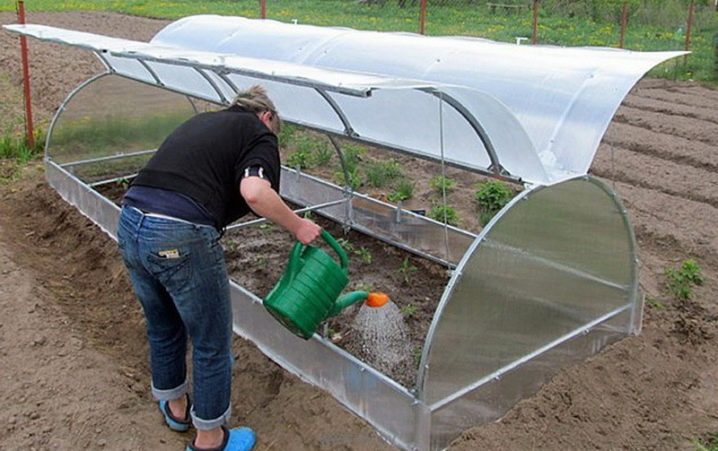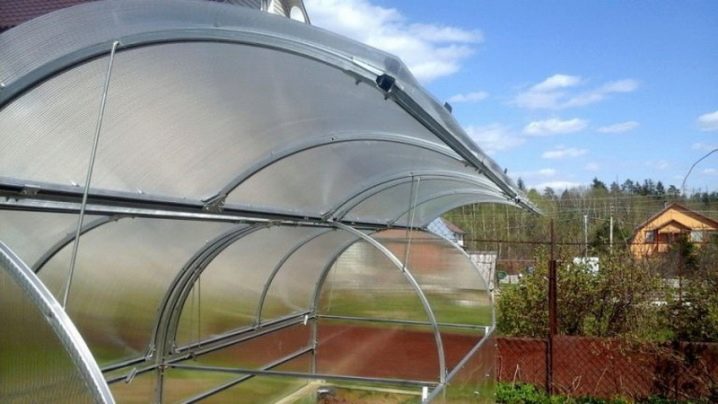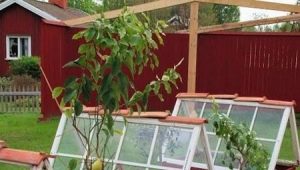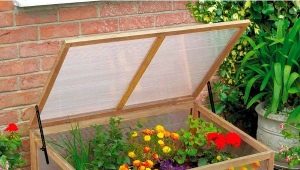Greenhouse "butterfly": the pros and cons
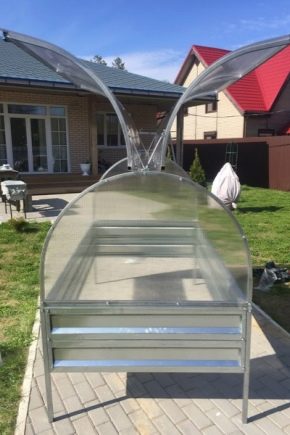
At the summer cottage it is impossible to do without a greenhouse or greenhouse. Now there are many options for how to make them yourself. With modern greenhouses to grow good seedlings get quickly and easily.
Distinctive features
A greenhouse is a construction of film, glass or polycarbonate and metal or wood. It is possible to grow seedlings much earlier. This is due to the fact that greenhouses are able to accumulate and retain heat, and their transparent walls allow penetration into the natural light. Especially they are irreplaceable if there is no place for a full-fledged greenhouse, but I really want to grow a crop earlier. In such designs it is easy to create the necessary microclimate for many plants and in any region.One of these convenient greenhouse structures is a butterfly.
This greenhouse received the unusual name for the peculiarities of its structure, more precisely, the side walls-windows. If necessary, they can lift and ventilate the internal space. In this form, the greenhouse resembles a beautiful butterfly, which spread its wings. The compact size of this design makes it very convenient. Working in such a place is pleasant and easy. Even there is no need to go on the beds. At the same time the internal space can be used with maximum efficiency.
Another plus is that under such a greenhouse there is no need to allocate too much space. As a rule, the length of the "butterfly" is about 2-2.5 m, width - 1.5 m, and height - a little more than a meter. On average, this design can be placed on five square meters. As for the mass of the greenhouse, it is about 30-32 kg. Butterfly-type greenhouse structures are sold in specialized stores. However, if desired, it is easy to make it yourself. When buying such a greenhouse you have to make a choice in favor of the metal frame. The best coating is cellular polycarbonate.If the structure is properly maintained, it can last for ten years or more.
To assemble a greenhouse according to the instructions is very simple. Each of the stages at which the installation is carried out is indicated in it accurately and clearly. Simplicity of assembly allows, if necessary, to rearrange or even transport the greenhouse anywhere. It should be noted that the “butterfly” does not need a foundation, any soil is suitable for its installation.
Incredibly, it is recommended to plant seedlings in such a greenhouse even earlier than in ordinary greenhouses. And there is an explanation for this - the space inside is less, in fact, like the amount of soil, which means that it will warm up faster with the sun. As a result, the formation of the desired microclimate will take less time. Summer residents consider the “butterfly” to be a reliable greenhouse that withstands bad weather and allows to achieve good results faster.
What is different from the greenhouse?
Experienced gardeners clearly understand that the greenhouse and greenhouse are different designs. Of course, they are similar in appearance, but their differences are very significant. First of all, they differ in size. Greenhouses are more compact, their height is less than human height.When working with a greenhouse garden resident is outside. Access inside is carried out by sliding or reclining walls, covers.
The main difference between a greenhouse and a greenhouse lies in the heating itself. At first, this process occurs only due to heat from the sun and compost. As for the second, they often use additional heating in the form of various heating systems. The simplicity and ease of greenhouse construction make it convenient both in installation and in placement. Even when installing it in a new place, one, maximum two people will cope with this. In addition, there is no need for laying the foundation, which simplifies the work.
It should be borne in mind that greenhouses are suitable for planting seedlings, as well as low-growing plants. For example, in such constructions it is convenient to grow onions, garlic, lettuce, strawberries.
There are no automated systems in the greenhouses, such as watering, ventilation, additional heating or lighting. As a result, the care of plants in them becomes more time consuming process. Production of greenhouses allows earlier and cheaper (compared to greenhouses) to grow many plants due to the special microclimate. The main work in such a structure makes the greenhouse effect.
Advantages and disadvantages
Like any structure, the "butterfly" has a number of advantages and disadvantages. Experienced gardeners note in the number of positive aspects that its internal space can be used very effectively. There are no passages inside the greenhouse, and the frames, which are easy to open, allow you to get the necessary access to the plants. This is especially appreciated by gardeners whose land plots do not have a large area and each meter is very much appreciated.
The design of the "butterfly" is very convenient, since with it you can easily get to any plant inside. There is no need to make extra efforts to this. Another advantage is the simple and quick installation of the structure. It didn’t matter whether the building was purchased ready-made or made independently, it is absolutely easy to install it. This task is under the power of any summer resident. It does not need any special wisdom or skills.
An important advantage of "butterflies" is also their small price. If you compare them with other greenhouses, it becomes clear that they are among the cheapest. However, it does not affect the seedlings grown in them.
The strength and durability of these structures also belong to the benefits. If you look at their specifications, you can see that greenhouses can withstand winds up to 20 meters per second and snow cover up to 10 centimeters. And if necessary, there is the possibility of strengthening the structure due to special supports. Another nice thing about these greenhouses is simple maintenance.
But the construction of the butterfly is somewhat smaller, and, as practice shows, they do not interfere with summer residents at all. Among the disadvantages most often there are defects of the edges. However, disturbing irregularities are easy to remove with a regular file. Also quite often there are designs with insufficiently reliable loops on which the frames are held. Of course, they can, if desired, be replaced with better and more durable ones.
When buying a finished structure, quite often the paint will quickly climb and an attractive look is lost. A new can of paint, a brush, a little time and skillful hands will help to cope with this. In that case, if the film serves as a greenhouse for a greenhouse, then it may be sinking under the influence of weather conditions or time. To prevent this from happening,it is enough to choose a "butterfly" with frames made of durable polycarbonate.
Kinds
Depending on the size, coating material and frameworks, "butterflies" are somewhat different from each other. The plants produce two variants of this type of greenhouse, which in fact differ only in their length. Before you make your choice, it’s worth exploring what a “breadbasket” can be.
Materials
The following materials can be used for the frames and sides of the butterfly.
- Wood. Although not a durable material, it is notable for its availability and ease of processing.
- Metal. This material impresses with its reliability and durability, but at the same time its price is higher. In order to frame the metal lasted longer, it needs special care.
Various materials are also used as a coating for greenhouse structures.
- Film. It is the cheapest material, but its main drawback is a short service life.
- Glass. To get this material is completely easy, but working with him is difficult and unsafe. Among the disadvantages of glass coating should be distinguished fragility and significant weight.
- Polycarbonate. Good modern material that is durable, long service life and ease of operation.
Dimensions
By the size of the greenhouse "butterfly" is divided into several types.
- Two meter. This view is a mini version. Its width is not more than 1.4 meters, height - from 90 to 110 centimeters, length - 2 m.
- Four meter. The width and height of it, as in the two-meter. The only difference is the length of 4 m.
How to choose?
When choosing a greenhouse for your site, you should first find out reviews about this or that option. To help determine the choice can be a clear idea of what it will be used for. For example, a greenhouse made of film is suitable for cucumbers, and for growing strawberries it is better to choose a polycarbonate construction. If you have time and opportunity, then, of course, it is better to make a greenhouse yourself. Directly to the frame is well suited as a metal, and wood. However, we must bear in mind that in order to avoid corrosion, one should choose a galvanized or painted metal. Of course, to work with him, you need special tools and skills. At a minimum, you must be able to work with welding.
When there is a desire to make a "butterfly" with your own hands, gardeners recommend choosing wood for the frame. Work with this material is simple and easy to purchase at an affordable price. However, in order for such a design to serve longer, it is desirable to treat it with paint. Otherwise, the "butterfly" can quickly rot or be attacked by parasites.
Coverage should be chosen based on how many seasons a greenhouse is needed. If only a couple, then enough cheap film. Also, this option will be good if the design is put only for the spring season, and then retracted. For more durable use, choose polycarbonate or glass. Of course, preference should be given to modern polycarbonate, since it is better able to withstand shocks, is lighter and easier to handle.
When choosing a greenhouse, special attention should be paid to fasteners, fasteners and various accessories. Both in the purchase and in the improvised construction all these elements must be of high quality. This will allow the design to be more comfortable and durable.
How to do?
There is nothing surprising in the fact that gardeners like the simple and convenient “butterfly” design.As a result, many people want to create it with their own hands. This option allows you to avoid many of the shortcomings that occur in commercial models.
Training
Start the creation of a greenhouse should be with the preparation. First, it is best to make drawings. Then you should take care of the necessary materials and tools. On hand should be a hacksaw, tape measure, hammer, screwdriver, scissors or construction knife, as well as nails, screws, metal corners, handles, sheds. When all of the above is ready, you can choose a place and prepare it for the installation of a greenhouse.
The place where it is planned to locate the structure should be well illuminated by sunlight. Therefore, it is not necessary to stop your choice on sites in the valley. Also, places where groundwater or precipitation accumulates will not work. Otherwise, the plants in the greenhouse will rot and rot. It is desirable that the length of the structure is located in the direction of north-south. If it is planned to create a buried structure, then it will be necessary to make a pit in the form of a trapezium. The depth of the pit should be approximately 30-90 cm. This parameter should be selected based on the local climate and on what the butterfly will be used for.
To strengthen the walls is best to use boards, and at the bottom put a mixture of manure, rotten leaves and peat. Other mixtures that are loose and generate heat can also be used. On top of the layer lies the ground with a height of 20-30 cm. On it are laid large logs that are recommended to knock down. The result should be a contour, which in all its parameters should correspond to the size of the future greenhouse construction.
Frame
Upon completion of all the preparatory work should proceed to the assembly of the frame structure. The simplest option is the arched frame. For its manufacture take bars with a diameter of 0.5 cm, with an insufficient length knock them. The result should be two rails with a length equal to the length of the structure. To them will be mounted coating. Also, the frame can be assembled from metal-plastic pipes, which are easily bent into the desired shape. However, it is more difficult to assemble a framework from them at a stage when it will be necessary to form opening flaps. According to experts, it is better to choose a wood or galvanized metal profile for the frame.
Sheet installation
When the frame is ready, you can begin to prepare the coating.The easiest option is to make polycarbonate flaps. To do this, take the usual sheet size 210 to 600 cm. Then cut it with a slender base into 4 pieces, 3 of which will be the same size. Now the canvases can be spread out on the frame so that their wide side runs along the bar. Fastening of polycarbonate should be carried out with screws. Laying canvas best overlap. For sizing the top sheet after fixing it is worth using scotch tape. When laying sheets, it is important that the sunscreen on them is facing out.
Next, the canvas must be bent in the form of an arch. To fix them, first a timber is attached to the frame with a diameter of 0.5 cm and a length of 150 cm. Then the canvases are fixed on the beam. It is worth noting that this procedure should be done from two sides.
Recommendations for use
The greenhouse "butterfly" with proper maintenance will last for decades. Experienced gardeners for this recommend gently closing the sash, no pops. If the structure for the winter is not removed, it is better to supplement its internal space with props. This will allow the greenhouse to withstand better snow debris. It is also necessary to wash the polycarbonate sash or glass well.
To install the "butterfly" is better to choose a flat area. In the autumn, it is imperative to disinfect the soil inside the structure using special means. The greenhouse should be painted regularly, and the metal frame should also be treated with an anti-corrosion agent. When damage and chips appear on the painted surface, it is necessary to carry out their prompt processing. To design served as long as possible, it is better to build a small foundation.
See how to collect the butterfly greenhouse in the next video.
